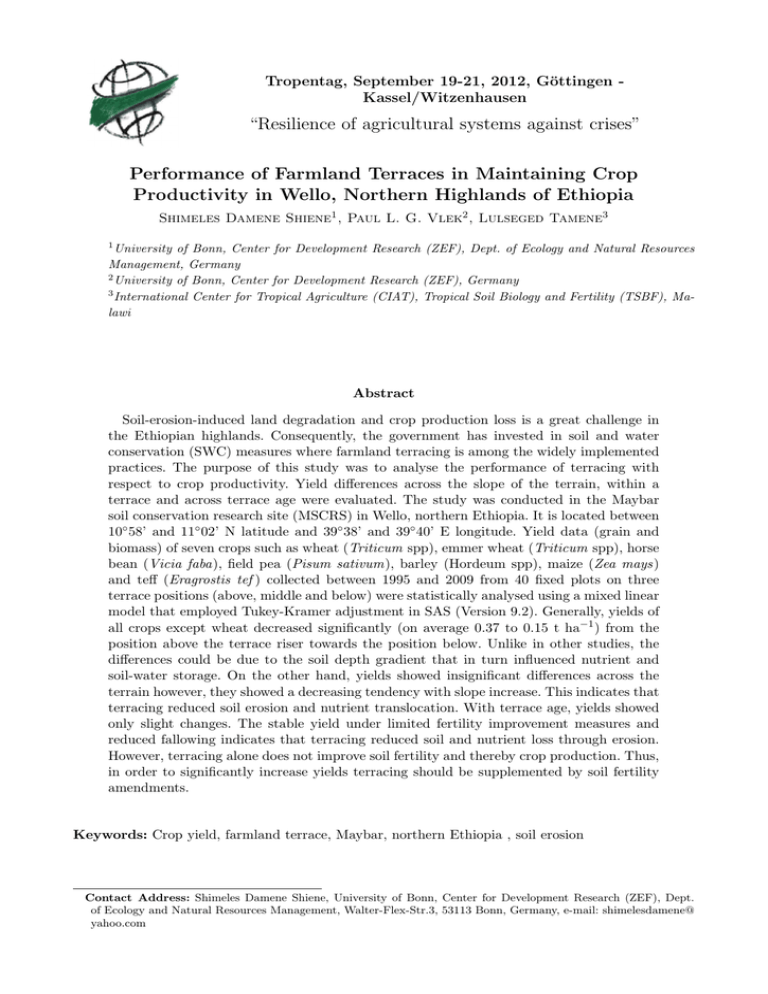“Resilience of agricultural systems against crises”
advertisement

Tropentag, September 19-21, 2012, Göttingen Kassel/Witzenhausen “Resilience of agricultural systems against crises” Performance of Farmland Terraces in Maintaining Crop Productivity in Wello, Northern Highlands of Ethiopia Shimeles Damene Shiene1 , Paul L. G. Vlek2 , Lulseged Tamene3 1 University of Bonn, Center for Development Research (ZEF), Dept. of Ecology and Natural Resources Management, Germany 2 University of Bonn, Center for Development Research (ZEF), Germany 3 International Center for Tropical Agriculture (CIAT), Tropical Soil Biology and Fertility (TSBF), Malawi Abstract Soil-erosion-induced land degradation and crop production loss is a great challenge in the Ethiopian highlands. Consequently, the government has invested in soil and water conservation (SWC) measures where farmland terracing is among the widely implemented practices. The purpose of this study was to analyse the performance of terracing with respect to crop productivity. Yield differences across the slope of the terrain, within a terrace and across terrace age were evaluated. The study was conducted in the Maybar soil conservation research site (MSCRS) in Wello, northern Ethiopia. It is located between 10◦ 58’ and 11◦ 02’ N latitude and 39◦ 38’ and 39◦ 40’ E longitude. Yield data (grain and biomass) of seven crops such as wheat (Triticum spp), emmer wheat (Triticum spp), horse bean (Vicia faba), field pea (Pisum sativum), barley (Hordeum spp), maize (Zea mays) and teff (Eragrostis tef ) collected between 1995 and 2009 from 40 fixed plots on three terrace positions (above, middle and below) were statistically analysed using a mixed linear model that employed Tukey-Kramer adjustment in SAS (Version 9.2). Generally, yields of all crops except wheat decreased significantly (on average 0.37 to 0.15 t ha−1 ) from the position above the terrace riser towards the position below. Unlike in other studies, the differences could be due to the soil depth gradient that in turn influenced nutrient and soil-water storage. On the other hand, yields showed insignificant differences across the terrain however, they showed a decreasing tendency with slope increase. This indicates that terracing reduced soil erosion and nutrient translocation. With terrace age, yields showed only slight changes. The stable yield under limited fertility improvement measures and reduced fallowing indicates that terracing reduced soil and nutrient loss through erosion. However, terracing alone does not improve soil fertility and thereby crop production. Thus, in order to significantly increase yields terracing should be supplemented by soil fertility amendments. Keywords: Crop yield, farmland terrace, Maybar, northern Ethiopia , soil erosion Contact Address: Shimeles Damene Shiene, University of Bonn, Center for Development Research (ZEF), Dept. of Ecology and Natural Resources Management, Walter-Flex-Str.3, 53113 Bonn, Germany, e-mail: shimelesdamene@ yahoo.com




